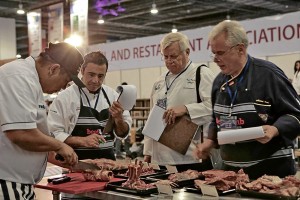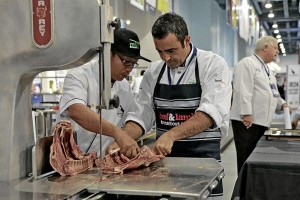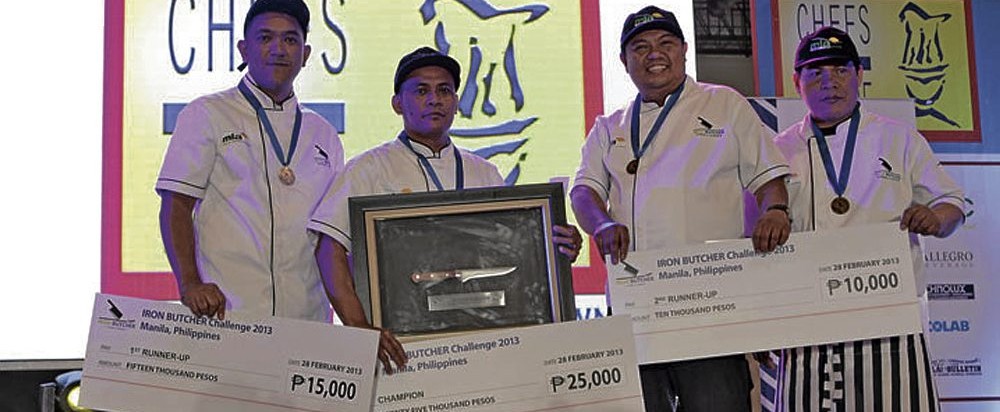
At the MLA Iron Butcher Challenge, competing professional butchers had to make different cuts on a whole carcass of lamb in one hour

There is something attractive about doing the right cut of meat. The slices come out neat. The pieces will cook uniformly at the same time. If there are bones, they will be harmless and will help in the presentation.
That is why I like to watch butchers in action. But even in supermarkets, a buyer doesn’t necessarily see them cutting the meat, because the cutting section is usually far from anyone’s view.
At the wet market, they work fast but rather haphazardly. And sometimes the cut isn’t as neat. I’ve had oxtail that had more rump than tail.
Unusual request
My most memorable butcher experience was in Iowa, USA. The supermarket in the town was known to have butchers who will cut the meat to your specification. We were going to cook adobo and we made one of them cut cubes out of pork shoulder butt. That’s the equivalent of kasim here. The butcher told us our request was most unusual.
Every country has its own way of cutting beef or pork. Our local butchers never did baby back ribs until there was a demand for it. And then there are the different names of cuts per country. Beef kabilugan is round in America and chuck tender in Australia.
I do attend seminars where master butchers teach their craft. This is usually conducted by Meat and Livestock Australia (MLA). There, butchers are taught how to get the most out of a particular cut. Or a different cut from what they’ve been doing before.
Will this homemaker ever apply those techniques? I would rather entrust the cutting to the butchers at the supermarket. I just want to know how.
Important cuts

When an invitation to watch the MLA Iron Butcher Challenge was extended, I gladly accepted. This was at the Chefs on Parade event last month.
Competing professional butchers had to make different cuts on a whole carcass of lamb in one hour. They had to do primals, or important cuts, such as lamb neck bone-in and lamb racks. Other cuts were up to the contestants, but they all had to conform to industry standards.
Many of the butchers had never cut lamb before. But they attended a seminar before the competition conducted by Rafael Ramirez, trainer for Meat and Livestock Australia and a butcher who manages a retail and food service outlet in Perth. According to some of the contestants, there are some similarities in making cuts of pork and beef that made it easy for them to apply to lamb cuts.
Every carcass had to go through Ramirez, who made the big cuts with the electric cutter used in butcher shops. Ramirez was also the head of the judges; they included Alan Palmer, who takes charge of the MLA Black Box Competition (cooking competition with a secret ingredient); and chef Michael George Oberle, Ichef director of culinary arts. They determined who among the butchers deserved the three winning places.
So what were the criteria?
Since I do judge several culinary competitions yearly, I guessed it should include the following: clean workstation, a minimum of wastage, proper presentation, clean cuts, clean work uniform and hair protection and finishing within the hour allotted.
Official criteria
A look at the official criteria showed I did guess correctly, but there were more specific butchery criteria. Knives had to be sharp. Boned lamb cuts should be trimmed and cleaned. Two lamb cuts had to be practical and commercially feasible. Certain cuts have to be suitable to cooking methods. Presentation had to be clean and properly labeled. A plus also for value-added applications like marinating, roasting, burger patties and meatballs.
So as I went through the workstations, I just had to look underneath the work area for how much wastage there was. Presentation sometimes included plastic leaves that I suppose were a good color contrast to the red meat. I wasn’t sure that was a good idea, though—combining natural with artificial.
There were some who cut neatly and, for several pieces of the same cut, the sizes were uniform. I suppose that’s the art in butchery and this is the first line in the art of cookery.
Winners
There were 14 butchers who participated from the meat sections of supermarkets, hotel kitchens and agricultural food companies. First place was Joemi Gan of Savemore Angono, who was awarded a unique butcher’s knife trophy, a professional MLA Butcher’s Knife Set and P25,000 cash prize.
Rommel Yanson of Good Savers was second. There were two third placers—Gregorio Nazareno of Acacia Hotel Manila and Nel Vergel of The Bellevue Manila.
Hermie Suangco of Meatworld International Inc. was given a special award for creativity and for presenting the best utilization of the carcass.
The next question was, so what happened to the lamb cuts? I was told that all the butchers went home with their own to cook. I wonder how many did lamb adobo, caldereta, sinigang.
E-mail [email protected]










































